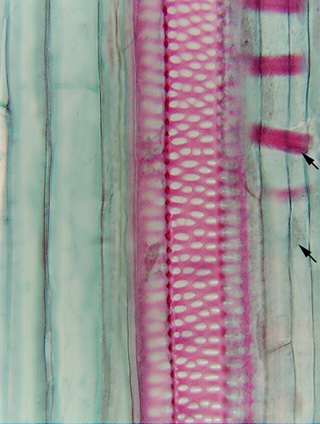 Fig.
7.2-8. Longitudinal section of vessel element of corn (Zea mays).
Corn is a flowering plant (as opposed to a conifer), so its circular bordered
pits are small, like those of American hornbeam in Fig. 7.2-7, rather than large
like those of pine in Fig. 7.2-6. Notice that these circular bordered pits are
not quite as orderly as the ones in American hornbeam; they are of
various sizes, some quite a bit larger than others, and they do not form a neat
hexagonal arrangement. The regularity of pitting is variable – in some
species, scalariform pits or circular bordered pits are remarkably regular; in
others, they are almost haphazard.
Fig.
7.2-8. Longitudinal section of vessel element of corn (Zea mays).
Corn is a flowering plant (as opposed to a conifer), so its circular bordered
pits are small, like those of American hornbeam in Fig. 7.2-7, rather than large
like those of pine in Fig. 7.2-6. Notice that these circular bordered pits are
not quite as orderly as the ones in American hornbeam; they are of
various sizes, some quite a bit larger than others, and they do not form a neat
hexagonal arrangement. The regularity of pitting is variable – in some
species, scalariform pits or circular bordered pits are remarkably regular; in
others, they are almost haphazard.